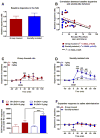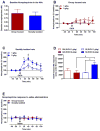Social isolation rearing increases nucleus accumbens dopamine and norepinephrine responses to acute ethanol in adulthood
- PMID: 25421514
- PMCID: PMC4519347
- DOI: 10.1111/acer.12555
Social isolation rearing increases nucleus accumbens dopamine and norepinephrine responses to acute ethanol in adulthood
Abstract
Background: Early-life stress is associated with increased vulnerability to alcohol addiction. However, the neural substrates linking chronic childhood/adolescent stress and increased risk of alcohol addiction are not well understood. In the nucleus accumbens (NAc), dopamine (DA) and norepinephrine (NE) signaling can be profoundly influenced by stress, anxiety, and drugs of abuse, including ethanol (EtOH). Here, we employed a rodent model of early-life stress that results in enduring increases in behavioral risk factors of alcoholism to gain a better understanding of how chronic adolescent stress may impact the EtOH sensitivity of DA and NE release in the NAc.
Methods: Male Long-Evans rats were either group housed (GH; 4 rats/cage) or socially isolated (SI; 1 rat/cage) for 6 weeks beginning on postnatal day 28. SI and GH rats were tested in adulthood for anxiety-like behaviors (elevated plus maze), and the effects of EtOH (1 and 2 g/kg; intraperitoneally.) on NAc DA and NE were assessed by microdialysis.
Results: SI animals showed increased anxiety-like behavior compared to GH animals. Although SI had no effect on baseline levels of DA or NE, baseline DA levels were positively correlated with anxiety measures. In addition, while no significant differences were observed with 1 g/kg EtOH, the 2 g/kg dose induced significantly greater DA release in SI animals. Moreover, EtOH (2 g/kg) only elevated NAc NE levels in SI rats.
Conclusions: These results suggest that chronic early-life stress sensitizes accumbal DA and NE release in response to an acute EtOH challenge. A greater EtOH sensitivity of DA and NE release dynamics in the NAc may contribute to increases in behavioral risk factors of alcoholism, like greater EtOH self-administration, that are observed in SI rats.
Keywords: Dopamine; Ethanol; Norepinephrine; Nucleus Accumbens; Social Isolation.
Copyright © 2014 by the Research Society on Alcoholism.
Figures






Similar articles
-
Chronic social isolation during adolescence augments catecholamine response to acute ethanol in the basolateral amygdala.Synapse. 2015 Aug;69(8):385-95. doi: 10.1002/syn.21826. Epub 2015 May 28. Synapse. 2015. PMID: 25963724 Free PMC article.
-
Early-Life Social Isolation Stress Increases Kappa Opioid Receptor Responsiveness and Downregulates the Dopamine System.Neuropsychopharmacology. 2016 Aug;41(9):2263-74. doi: 10.1038/npp.2016.21. Epub 2016 Feb 10. Neuropsychopharmacology. 2016. PMID: 26860203 Free PMC article.
-
Adolescent rearing conditions influence the relationship between initial anxiety-like behavior and ethanol drinking in male Long Evans rats.Alcohol Clin Exp Res. 2013 Jan;37 Suppl 1(Suppl 1):E394-403. doi: 10.1111/j.1530-0277.2012.01926.x. Epub 2012 Aug 24. Alcohol Clin Exp Res. 2013. PMID: 22924742 Free PMC article.
-
Adolescent Social Isolation as a Model of Heightened Vulnerability to Comorbid Alcoholism and Anxiety Disorders.Alcohol Clin Exp Res. 2016 Jun;40(6):1202-14. doi: 10.1111/acer.13075. Epub 2016 May 7. Alcohol Clin Exp Res. 2016. PMID: 27154240 Free PMC article. Review.
-
Social consequences of ethanol: Impact of age, stress, and prior history of ethanol exposure.Physiol Behav. 2015 Sep 1;148:145-50. doi: 10.1016/j.physbeh.2014.11.062. Epub 2014 Nov 26. Physiol Behav. 2015. PMID: 25431835 Free PMC article. Review.
Cited by
-
Nine-month-long Social Isolation Changes the Levels of Monoamines in the Brain Structures of Rats: A Comparative Study of Neurochemistry and Behavior.Neurochem Res. 2023 Jun;48(6):1755-1774. doi: 10.1007/s11064-023-03858-3. Epub 2023 Jan 21. Neurochem Res. 2023. PMID: 36680692
-
Areas of Convergence and Divergence in Adolescent Social Isolation and Binge Drinking: A Review.Front Behav Neurosci. 2022 Mar 30;16:859239. doi: 10.3389/fnbeh.2022.859239. eCollection 2022. Front Behav Neurosci. 2022. PMID: 35431830 Free PMC article. Review.
-
Long-Term Behavioral Effects of Post-weaning Social Isolation in Males and Females.Front Behav Neurosci. 2019 Apr 11;13:66. doi: 10.3389/fnbeh.2019.00066. eCollection 2019. Front Behav Neurosci. 2019. PMID: 31031604 Free PMC article.
-
Persistent behavioral and neurobiological consequences of social isolation during adolescence.Semin Cell Dev Biol. 2021 Oct;118:73-82. doi: 10.1016/j.semcdb.2021.05.017. Epub 2021 Jun 8. Semin Cell Dev Biol. 2021. PMID: 34112579 Free PMC article. Review.
-
Sexually dimorphic effects of a modified adolescent social isolation paradigm on behavioral risk factors of alcohol use disorder in Long Evans Rats.Addict Neurosci. 2023 Dec 15;9:100134. doi: 10.1016/j.addicn.2023.100134. Epub 2023 Nov 4. Addict Neurosci. 2023. PMID: 38188062 Free PMC article.
References
-
- Alquicer G, Morales-Medina JC, Quirion R, Flores G. Postweaning social isolation enhances morphological changes in the neonatal ventral hippocampal lesion rat model of psychosis. J Chem Neuroanat. 2008;35:179–187. - PubMed
-
- Anda RF, Whitfield CL, Felitti VJ, Chapman D, Edwards VJ, Dube SR, Williamson DF. Adverse childhood experiences, alcoholic parents, and later risk of alcoholism and depression. Psychiatr Serv. 2002;53:1001–1009. - PubMed
-
- Berridge CW, Stratford TL, Foote SL, Kelley AE. Distribution of dopamine beta-hydroxylase-like immunoreactive fibers within the shell subregion of the nucleus accumbens. Synapse. 1997;27:230–241. - PubMed
-
- Bortolato M, Deoto P, Roncada P, Frau R, Flore G, Saba P, Pistritto G, Soggiu A, Pisanu S, Zappala A, Ristaldi MS, Tattoli M, Cuomo V, Marrosu F, Barbaccia ML. Isolation rearing-induced reduction of brain 5α-reductase expression: relevance to dopaminergic impairments. Neuropharmacology. 2011;7–8:1301–1308. - PubMed
-
- Brenes JC, Rodriguez O, Fornaguera J. Differential effect of environment enrichment and social isolation on depressive-like behavior, spontaneous activity and serotonin and norepinephrine concentration in prefrontal cortex and ventral striatum. Pharmacol Biochem Behav. 2008;89:85–93. - PubMed
Publication types
MeSH terms
Substances
Grants and funding
LinkOut - more resources
Full Text Sources
Other Literature Sources
Medical

